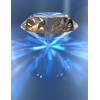|
 In the opinion
of our forefathers the precious stones were powerful enough to keep off evil
angels, ghosts, letting alone the ability to heal psychic diseases. In ancient
time these stones strengthened the will of worriers and supported the owners in
tight spot. As the old times traditions say, diamonds in every corner of the
housing protected from thunder and lightning. Diamonds were considered to own
magic to bring luck, and on the top of it, some stones shined in the darkness
causing mystic horror and admiration. In the opinion
of our forefathers the precious stones were powerful enough to keep off evil
angels, ghosts, letting alone the ability to heal psychic diseases. In ancient
time these stones strengthened the will of worriers and supported the owners in
tight spot. As the old times traditions say, diamonds in every corner of the
housing protected from thunder and lightning. Diamonds were considered to own
magic to bring luck, and on the top of it, some stones shined in the darkness
causing mystic horror and admiration.
The Indians
held the opinion that human spirits live in diamonds. The Greeks found them as
God's tears while earliest philosophers deemed that stones are ‘women' and
‘men' alike and that they could even procreate. Sometimes the gem was called
conciliation stone for it could bring a couple together. And the interesting fact,
this stone could cope with the human evil to lie.
The nobles had
diamonds on them to protect themselves from poisoning. That time diamantine was
found to be one of the popular poisons. The history says that the Turkish sultan
Bayazet was poisoned by his son who sneaked and put the poisoning powder into
the food. Catherine de Médicis is the legendary person with the habit to deal
shortly with her enemies. In 1532 Clemens VII suddenly passed away when doctors
feed him with diamond powder, while the famous sculptor Benvenuto Cellini described
how enemies wanted to poison him the same way. The gossips of poisoning ability
of diamonds were likely created to protect diamonds from steal. Diamonds
throughout the History
India was the
biggest country to supply diamond to the world market. In XVIII stones were mined in Brazil and later
precious deposits were discovered in South Africa. And only in 1954 in Siberia they discovered
beds of diamonds in enormous value. However diamond production is actively
limited (and concern de Beers, the reputed monopolist at the market of diamond)
to keep the cost.
Previously precious
stones were used as charms but not as jewels (as rings sometimes), therefore they
were not processed. The crown of the Hungary King was likely happened to be the
first precious jewel of 1074. Yet, 400 years after diamond production was
initiated in Europe.
In XVI century
the romantic British young men scratched with diamonds love words and proposals
to their beloved on the walls of their houses. Thus, this kinds of jewels was called
‘scratch rings'.
Antwerp was
the biggest world place to process diamonds, though after being attacked by the
Spanish in 1585 году, Amsterdam took in hand mining of diamonds. The Netherlands
was famous for its tolerance while many diamond masters believed in Judaism.
The British
made London the second place in the world to process this precious stone after
India was conquered. At present masters of Belgium, India, Israel, South Africa
and USA are really worth mentioning as qualified jewelers.
|